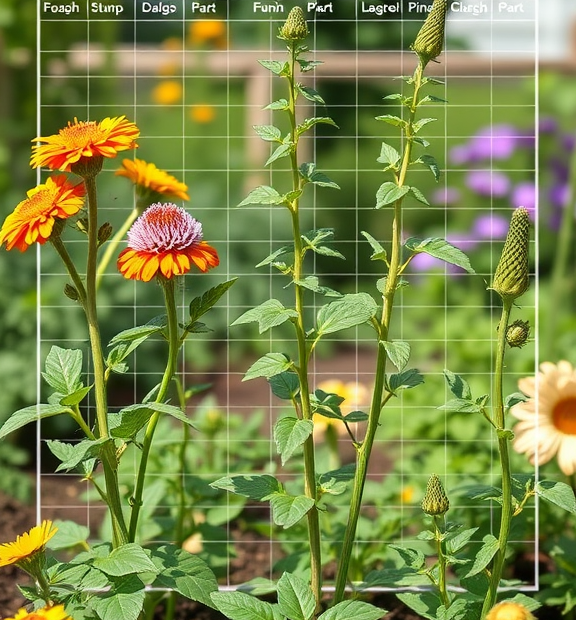Understanding the Benefits of a Companion Planting Chart
If you are looking to maximize your garden’s potential, understanding how a companion planting chart can help you is key. Companion planting is the practice of growing different plants together to enhance growth, repel pests, and improve soil health. By utilizing a companion planting chart, you can make informed decisions about what to plant next to each other for optimal results.
One of the primary benefits of using a companion planting chart is pest control. Certain plants can deter harmful pests naturally. For instance, marigolds are known to ward off nematodes and other insects. When you place them near tomatoes or peppers, you’ll find that your garden is less affected by those pesky critters. This method eliminates the need for chemical pesticides, making your garden healthier and more sustainable.
Companion planting also promotes beneficial relationships between plants. Some plants, when grown together, can encourage each other’s growth. This is often referred to as “allelopathy,” where one plant improves the conditions for another. For example, planting basil near tomatoes not only enhances the flavor of the tomatoes but can also protect them from the tomato hornworm.
Enhancing nutrient uptake is another significant advantage of utilizing a companion planting chart. Different plants can help each other access nutrients in the soil. For instance, legumes like beans have the ability to fix nitrogen in the soil, while corn requires a good amount of nitrogen to grow tall and strong. When you plant these together, you are creating a beneficial relationship that ensures both plants thrive.
Additionally, a companion planting chart helps in maximizing space in your garden. If you are working with a limited area, knowing which plants can coexist will allow you to use your space more efficiently. By planting taller crops next to shorter ones or those that spread horizontally, you are effectively layering your plants for both sunlight and nutrients.
To make the most of your garden, consider the following key pairings that you can find on a companion planting chart:
- Tomatoes and basil: Together, they improve flavor and repel certain pests.
- Carrots and onions: Onions can help deter carrot flies.
- Cucumbers and beans: Beans fix nitrogen in the soil, benefiting cucumbers.
- Cabbage and dill: Dill attracts beneficial insects that protect cabbage from pests.
- Spinach and strawberries: Strawberries act as a ground cover, preventing weeds that can compete with spinach.
It’s also essential to consider factors such as plant height and spread when using a companion planting chart. For example, planting a tall plant like corn next to a low-growing plant like squash can create a mutually beneficial relationship. The corn provides shade while the squash is safe from the sun’s harsh rays. This relationship allows both plants to thrive rather than compete.
Love what I do? Be a hero and help me keep creating awesome content!
Support My Mission Now!Every donation fuels more great stuff – thank you, legend!
Moreover, companion planting can improve pollination. Some plants attract beneficial pollinators, which can help nearby crops produce more fruits and vegetables. Butterflies, bees, and other insects are drawn to brightly colored flowers, making them excellent companions to fruiting plants. When you reference a companion planting chart, look for plants that are known to attract pollinators to boost your garden’s productivity.
A companion planting chart not only benefits the plants that you choose but also contributes to a healthier garden ecosystem overall. Since companion planting minimizes pesticide use and promotes natural pest control, it encourages biodiversity. A varied environment will create more habitats for wildlife, making your garden a sustainable haven.
Love what I do? Be a hero and help me keep creating awesome content!
Support My Mission Now!Every donation fuels more great stuff – thank you, legend!
Understanding the benefits of a companion planting chart is essential for anyone aiming to enhance their gardening experience. By knowing which plants work well together, you can improve pest control, boost nutrient uptake, maximize space, and promote pollination. With a wealth of information at your fingertips from a companion planting chart, you can create an efficient and thriving garden.
How to Create Your Own Companion Planting Guide
Creating your own companion planting guide can be a rewarding and enlightening experience. Companion planting allows different plant species to thrive together, benefiting from each other’s strengths while minimizing pests and diseases. Here are the steps to help you develop a guide that suits your gardening needs.
Understand the Basics of Companion Planting
Before diving into creating your guide, it’s essential to grasp the fundamentals of companion planting. This practice revolves around the idea that certain plants can enhance each other’s growth, repel pests, or attract beneficial insects. For beginners, familiarizing yourself with basic plant relationships can keep your garden flourishing. Here are some basic concepts:
- Enhancers: Some plants boost the growth of neighboring plants. For example, basil helps tomato plants grow better.
- Pest Repellers: Certain plants deter pests that could harm your crops. Marigolds, for instance, can keep nematodes at bay.
- Attractors: Flowers like nasturtiums attract beneficial insects which can help pollinate crops and keep harmful insects at a distance.
Research and Collect Data
Love what I do? Be a hero and help me keep creating awesome content!
Support My Mission Now!Every donation fuels more great stuff – thank you, legend!
To create a comprehensive guide, begin by gathering information about various plants. You can find resources such as gardening books, reputable websites, and local gardening clubs to enhance your understanding. When researching, focus on:
- The growth habits of plants (height, spread, and growth rate)
- Planting zones and seasonal growing conditions
- Specific benefits of pairing plants—like pest control or enhanced flavor
Identify Compatible Plant Combinations
Once you have gathered sufficient data, it’s time to identify compatible plants. Make a list of the plants you wish to grow and cross-reference their compatibility. Some classic companion pairings include:
- Tomatoes and Basil: These two love to grow together. Basil can deter aphids and spider mites, while enhancing the flavor of tomatoes.
- Carrots and Onions: Carrots help deter the onion fly, and onions help mask the scent of carrots from pests.
- Beans and Corn: Beans fix nitrogen in the soil, benefiting corn while providing a natural trellis for climbing.
Create Your Companion Planting Chart
Love what I do? Be a hero and help me keep creating awesome content!
Support My Mission Now!Every donation fuels more great stuff – thank you, legend!
Now, with your compatible plant combinations in mind, begin creating your companion planting chart. Start with a blank grid or table format. You can designate the rows for one plant and the columns for possible companions. Here’s how to structure it:
- Column 1: List the primary plants you’re focusing on.
- Columns 2 onward: List compatible companions and any additional notes like pest deterrents or soil preferences.
For example:
| Primary Plant | Compatible Companion | Notes |
|---|---|---|
| Tomatoes | Basil | Enhances flavor, deters pests |
| Carrots | Onions | Masking scent, pest control |
Consider Spatial Arrangement
When planning your garden layout, consider how much space each plant needs. Some plants grow tall while others spread wide. This consideration ensures that each plant has room to thrive and access to sunlight, air, and nutrients. A practical tip is to use vertical gardening for climbing plants; this maximizes space while efficiently using the garden area.
Test and Revise Your Guide
After creating your initial companion planting guide, implement it in your garden. Observe the results throughout the growing season. Take notes on plant health, pest occurrences, and overall yield. Don’t hesitate to revise your guide based on your findings. Gardening is an ongoing learning process, and adapting is crucial for success.
Creating your own companion planting guide is an excellent way to become more attuned to your garden’s needs. Not only will this enhance the health of your plants, but it can also lead to a more enjoyable gardening experience. Remember, the key is observation and adaptation, so keep track of what works best for you.
Conclusion
Utilizing a companion planting chart can transform your gardening experience by enhancing plant growth, reducing pests, and improving yield. With an understanding of the unique relationships between different plants, you can create a thriving ecosystem right in your garden. This isn’t just about growing more; it’s about growing smarter.
Creating your own companion planting guide allows you to customize your garden’s layout to meet the specific conditions and needs of your environment. By taking into consideration factors like sunlight, moisture, and soil quality, you can design a chart that maximizes the benefits for your plants. As you experiment with various combinations, you’ll gain valuable insight into how different plants interact. This hands-on approach not only fosters a deeper connection with your garden but also empowers you as a gardener.
Remember, companion planting is not a one-size-fits-all solution. It requires observation and a bit of patience. As you monitor the growth and health of your plants, you’ll discover which combinations thrive best in your unique environment. Each season brings new opportunities to refine your chart and enhance your gardening skills.
So, roll up your sleeves and dive into the exciting world of companion planting. With your personalized chart as a guide, watch your garden bloom and flourish in ways you never thought possible. Happy gardening!

